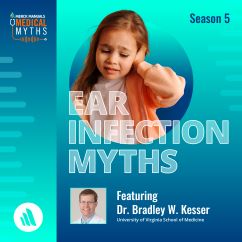Dermatitis of the ear canal is characterized by pruritis, scaling, flaking, and erythema of the skin of the external auditory meatus and ear canal. Dermatitis can be caused by exposure to allergens (contact dermatitis) or can be spontaneous (chronic otitis externa, aural eczematoid dermatitis).
Common contact allergens include nickel-containing earrings and numerous beauty products (eg, hairsprays, lotions, hair dye). Aural eczematoid dermatitis is more common among people with a predisposition toward atopy and with other similar dermatitides (eg, seborrhea, psoriasis).
Both contact dermatitis and aural eczematoid dermatitis cause itching, redness, clear (serous) discharge, desquamation, hyperpigmentation, and, sometimes, fissuring. A secondary bacterial infection can occur (acute otitis externa); this infection tends to cause pain more than itching. Irritants (eg, water, cotton-tipped applicators) can exacerbate both types.
Diagnosis is usually obvious based on physical examination. Contact dermatitis and aural eczematoid dermatitis are distinguished only by the presence of a known contact allergen (eg, use of earrings that contain nickel in contact dermatitis).
Treatment of Chronic Otitis Externa
Avoidance of triggers and/or irritants, including water and cotton-tipped applicators
Usually topical corticosteroids
(See also Otitis Externa and Assessment and Management of Chronic Otitis Externa..)
Contact dermatitis of the ear requires avoidance or withdrawal of allergic triggers, especially earrings. Trial and error may be needed to identify the offending agent. Topical corticosteroids (eg, 1% hydrocortisone cream or a more potent 0.1% betamethasone cream) can decrease inflammation and itching. Patients should avoid using cotton swabs, water, and other potential irritants in the ear because these will aggravate the inflammatory process. Recalcitrant cases can be treated with a short course of an oral corticosteroid (eg, prednisone).of the ear requires avoidance or withdrawal of allergic triggers, especially earrings. Trial and error may be needed to identify the offending agent. Topical corticosteroids (eg, 1% hydrocortisone cream or a more potent 0.1% betamethasone cream) can decrease inflammation and itching. Patients should avoid using cotton swabs, water, and other potential irritants in the ear because these will aggravate the inflammatory process. Recalcitrant cases can be treated with a short course of an oral corticosteroid (eg, prednisone).
Aural eczematoid dermatitis can be treated with dilute aluminum acetate solution (Burow solution), which can be applied as often as required for comfort. Itching and inflammation can be reduced with topical corticosteroids (eg, 0.1% betamethasone cream). Topical therapy with selenium disulfide shampoo can also be effective. If can be treated with dilute aluminum acetate solution (Burow solution), which can be applied as often as required for comfort. Itching and inflammation can be reduced with topical corticosteroids (eg, 0.1% betamethasone cream). Topical therapy with selenium disulfide shampoo can also be effective. Ifacute external otitis ensues, careful debridement of the ear canal and topical therapy (eg, ciprofloxacin 0.3%/dexamethasone 0.1%) may be required. Potential irritants, including water and cotton swabs, should be avoided.ensues, careful debridement of the ear canal and topical therapy (eg, ciprofloxacin 0.3%/dexamethasone 0.1%) may be required. Potential irritants, including water and cotton swabs, should be avoided.

